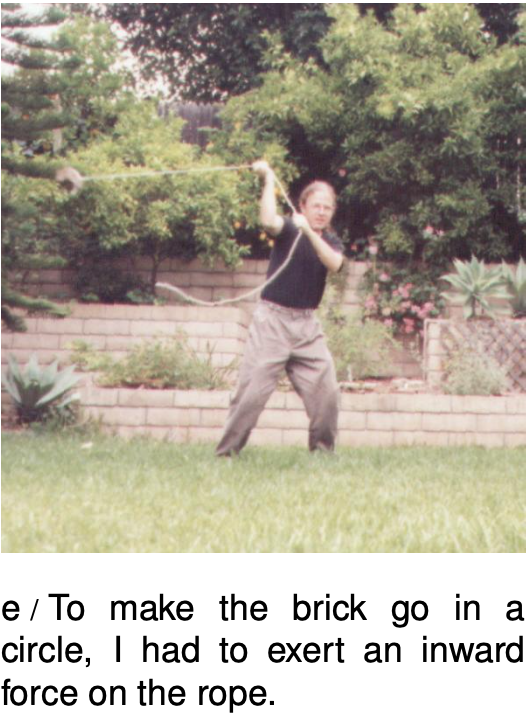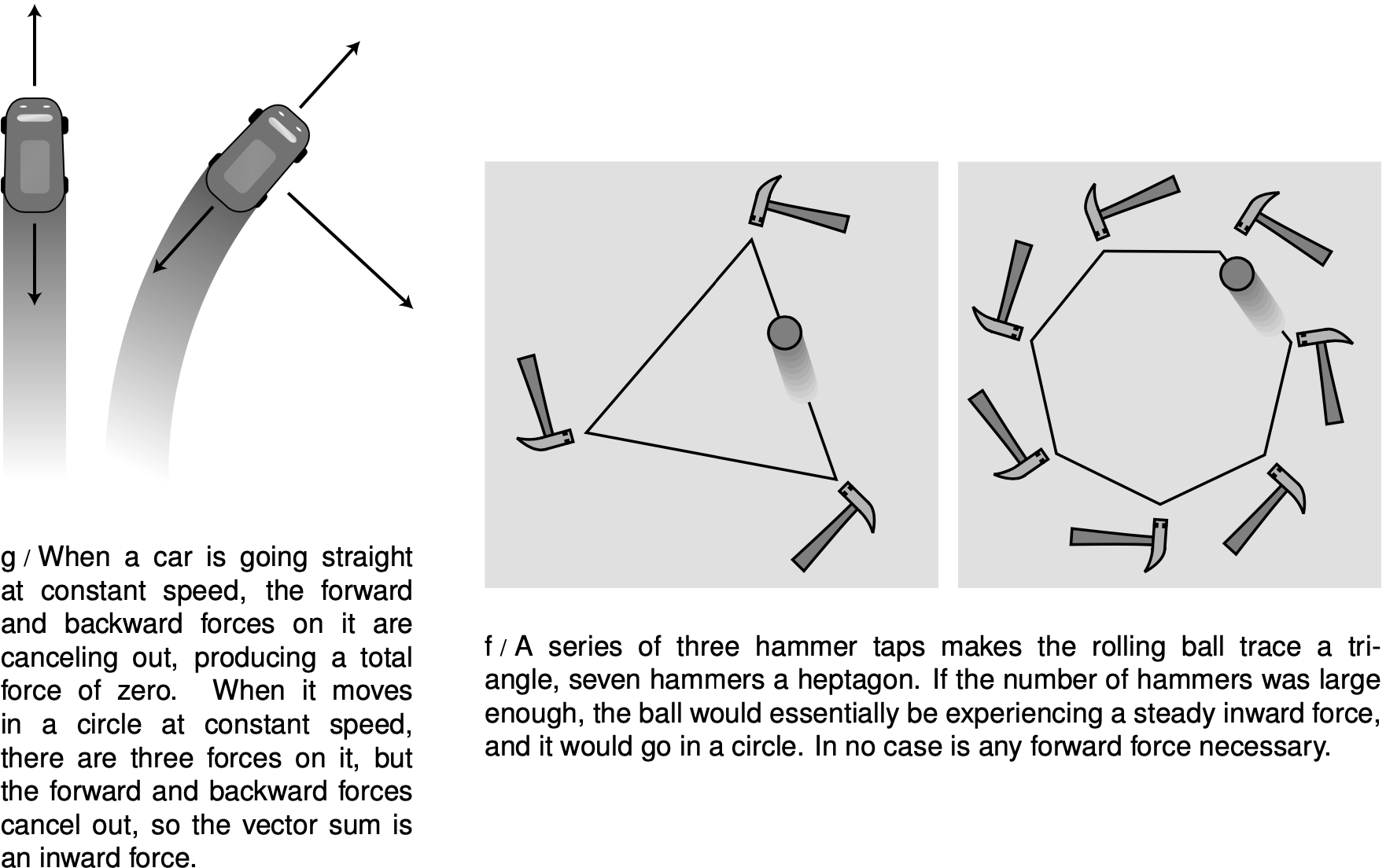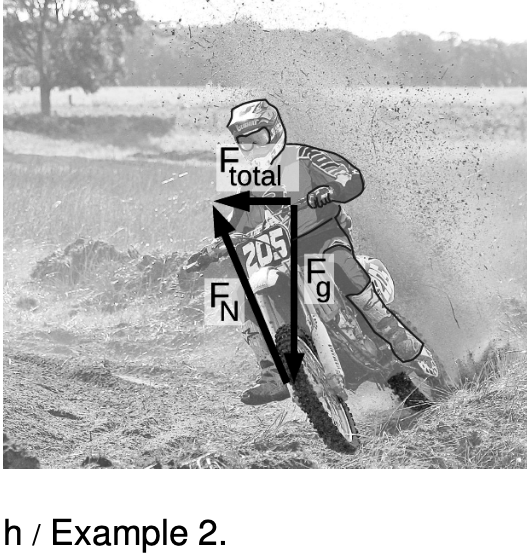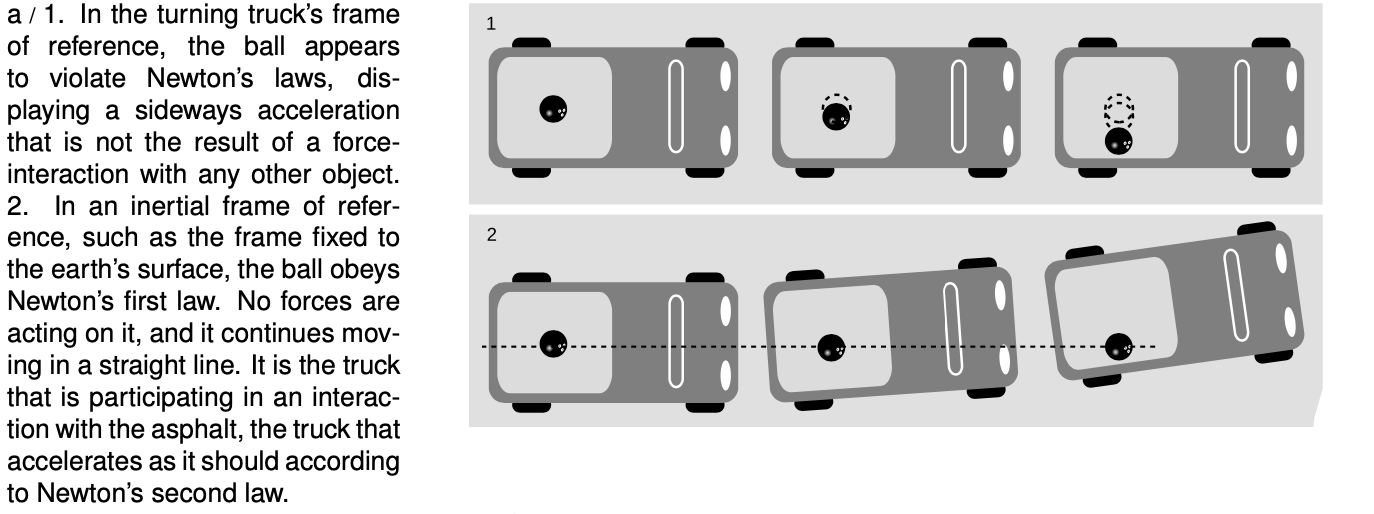9.1 Conceptual framework by Benjamin Crowell, Light and Matter licensed under the Creative Commons Attribution-ShareAlike license.
9.1 Conceptual framework
I now live fifteen minutes from Disneyland, so my friends and family in my native Northern California think it's a little strange that I've never visited the Magic Kingdom again since a childhood trip to the south. The truth is that for me as a preschooler, Disneyland was not the Happiest Place on Earth. My mother took me on a ride in which little cars shaped like rocket ships circled rapidly around a central pillar. I knew I was going to die. There was a force trying to throw me outward, and the safety features of the ride would surely have been inadequate if I hadn't screamed the whole time to make sure Mom would hold on to me. Afterward, she seemed surprisingly indifferent to the extreme danger we had experienced.
Circular motion does not produce an outward force
My younger self's understanding of circular motion was partly right and partly wrong. I was wrong in believing that there was a force pulling me outward, away from the center of the circle. The easiest way to understand this is to bring back the parable of the bowling ball in the pickup truck from chapter 4. As the truck makes a left turn, the driver looks in the rearview mirror and thinks that some mysterious force is pulling the ball outward, but the truck is accelerating, so the driver's frame of reference is not an inertial frame. Newton's laws are violated in a noninertial frame, so the ball appears to accelerate without any actual force acting on it. Because we are used to inertial frames, in which accelerations are caused by forces, the ball's acceleration creates a vivid illusion that there must be an outward force.
In an inertial frame everything makes more sense. The ball has no force on it, and goes straight as required by Newton’s first law. The truck has a force on it from the asphalt, and responds to it by accelerating (changing the direction of its velocity vector) as Newton’s second law says it should.
 Example 1: The halteres
Example 1: The halteres
Another interesting example is an insect organ called the halteres, a pair of small knobbed limbs behind the wings, which vibrate up and down and help the insect to maintain its orientation in flight. The halteres evolved from a second pair of wings possessed by earlier insects. Suppose, for example, that the halteres are on their upward stroke, and at that moment an air current causes the fly to pitch its nose down. The halteres follow Newton's first law, continuing to rise vertically, but in the fly's rotating frame of reference, it seems as though they have been subjected to a backward force. The fly has special sensory organs that perceive this twist, and help it to correct itself by raising its nose.
Circular motion does not persist without a force
I was correct, however, on a different point about the Disneyland ride. To make me curve around with the car, I really did need some force such as a force from my mother, friction from the seat, or a normal force from the side of the car. (In fact, all three forces were probably adding together.) One of the reasons


why Galileo failed to refine the principle of inertia into a quantitative statement like Newton's first law is that he was not sure whether motion without a force would naturally be circular or linear. In fact, the most impressive examples he knew of the persistence of motion were mostly circular: the spinning of a top or the rotation of the earth, for example. Newton realized that in examples such as these, there really were forces at work. Atoms on the surface of the top are prevented from flying off straight by the ordinary force that keeps atoms stuck together in solid matter. The earth is nearly all liquid, but gravitational forces pull all its parts inward.
Uniform and nonuniform circular motion
Circular motion always involves a change in the direction of the velocity vector, but it is also possible for the magnitude of the velocity to change at the same time. Circular motion is referred to as uniform if |v| is constant, and nonuniform if it is changing.
Your speedometer tells you the magnitude of your car's velocity vector, so when you go around a curve while keeping your speedometer needle steady, you are executing uniform circular motion. If your speedometer reading is changing as you turn, your circular motion is nonuniform. Uniform circular motion is simpler to analyze mathematically, so we will attack it first and then pass to the nonuniform case.
self-check:
Which of these are examples of uniform circular motion and which are nonuniform?
(1) the clothes in a clothes dryer (assuming they remain against the inside of the drum, even at the top)
(2) a rock on the end of a string being whirled in a vertical circle
(answer in the back of the PDF version of the book)
Only an inward force is required for uniform circular motion.
 Figure c showed the string pulling in straight along a radius of the circle, but many people believe that when they are doing this they must be “leading” the rock a little to keep it moving along. That is, they believe that the force required to produce uniform circular motion is not directly inward but at a slight angle to the radius of the circle. This intuition is incorrect, which you can easily verify for yourself now if you have some string handy. It is only while you are getting the object going that your force needs to be at an angle to the radius. During this initial period of speeding up, the motion is not uniform. Once you settle down into uniform circular motion, you only apply an inward force.
Figure c showed the string pulling in straight along a radius of the circle, but many people believe that when they are doing this they must be “leading” the rock a little to keep it moving along. That is, they believe that the force required to produce uniform circular motion is not directly inward but at a slight angle to the radius of the circle. This intuition is incorrect, which you can easily verify for yourself now if you have some string handy. It is only while you are getting the object going that your force needs to be at an angle to the radius. During this initial period of speeding up, the motion is not uniform. Once you settle down into uniform circular motion, you only apply an inward force.

If you have not done the experiment for yourself, here is a theoretical argument to convince you of this fact. We have discussed in chapter 6 the principle that forces have no perpendicular effects. To keep the rock from speeding up or slowing down, we only need to make sure that our force is perpendicular to its direction of motion. We are then guaranteed that its forward motion will remain unaffected: our force can have no perpendicular effect, and there is no other force acting on the rock which could slow it down. The rock requires no forward force to maintain its forward motion, any more than a projectile needs a horizontal force to “help it over the top” of its arc.
 Why, then, does a car driving in circles in a parking lot stop executing uniform circular motion if you take your foot off the gas? The source of confusion here is that Newton's laws predict an object's motion based on the total force acting on it. A car driving in circles has three forces on it
Why, then, does a car driving in circles in a parking lot stop executing uniform circular motion if you take your foot off the gas? The source of confusion here is that Newton's laws predict an object's motion based on the total force acting on it. A car driving in circles has three forces on it
(1) an inward force from the asphalt, controlled with the steering wheel;
(2) a forward force from the asphalt, controlled with the gas pedal; and
(3) backward forces from air resistance and rolling resistance.
You need to make sure there is a forward force on the car so that the backward forces will be exactly canceled out, creating a vector sum that points directly inward.
Example 2: A motorcycle making a turn
The motorcyclist in figure h is moving along an arc of a circle. It looks like he's chosen to ride the slanted surface of the dirt at a place where it makes just the angle he wants, allowing him to get the force he needs on the tires as a normal force, without needing any frictional force. The dirt's normal force on the tires points up and to our left. The vertical component of that force is canceled by gravity, while its horizontal component causes him to curve.
In uniform circular motion, the acceleration vector is inward.
Since experiments show that the force vector points directly inward, Newton's second law implies that the acceleration vector points inward as well. This fact can also be proven on purely kinematical grounds, and we will do so in the next section.
Example 3: Clock-comparison tests of Newton's first law
Immediately after his original statement of the first law in the Principia Mathematica, Newton offers the supporting example of a spinning top, which only slows down because of friction. He describes the different parts of the top as being held together by “cohesion,” i.e., internal forces. Because these forces act toward the center, they don't speed up or slow down the motion. The applicability of the first law, which only describes linear motion, may be more clear if we simply take figure f as a model of rotation. Between hammer taps, the ball experiences no force, so by the first law it doesn't speed up or slow down.
Suppose that we want to subject the first law to a stringent experimental test. The law predicts that if we use a clock to measure the rate of rotation of an object spinning frictionlessly, it won't “naturally” slow down as Aristotle would have expected. But what is a clock but something with hands that rotate at a fixed rate? In other words, we are comparing one clock with another. This is called a clock-comparison experiment. Suppose that the laws of physics weren't purely Newtonian, and there really was a very slight Aristotelian tendency for motion to slow down in the absence of friction. If we compare two clocks, they should both slow down, but if they aren't the same type of clock, then it seems unlikely that they would slow down at exactly the same rate, and over time they should drift further and further apart.
High-precision clock-comparison experiments have been done using a variety of clocks. In atomic clocks, the thing spinning is an atom. Astronomers can observe the rotation of collapsed stars called pulars, which, unlike the earth, can rotate with almost no disturbance due to geological activity or friction induced by the tides. In these experiments, the pulsars are observed to match the rates of the atomic clocks with a drift of less than about 10-6 seconds over a period of 10 years. Atomic clocks using atoms of different elements drift relative to one another by no more than about 10-16per year.
It is not presently possible to do experiments with a similar level of precision using human-scale rotating objects. However, a set of gyroscopes aboard the Gravity Probe B satellite were allowed to spin weightlessly in a vacuum, without any physical contact that would have caused kinetic friction. Their rotation was extremely accurately monitored for the purposes of another experiment (a test of Einstein's theory of general relativity, which was the purpose of the mission), and they were found to be spinning down so gradually that they would have taken about 10,000 years to slow down by a factor of two. This rate was consistent with estimates of the amount of friction to be expected from the small amount of residual gas present in the vacuum chambers.
A subtle point in the interpretation of these experiments is that if there was a slight tendency for motion to slow down, we would have to decide what it was supposed to slow down relative to. A straight-line motion that is slowing down in some frame of reference can always be described as speeding up in some other appropriately chosen frame (problem 12, p. 90). If the laws of physics did have this slight Aristotelianism mixed in, we could wait for the anomalous acceleration or deceleration to stop. The object we were observing would then define a special or “preferred” frame of reference. Standard theories of physics do not have such a preferred frame, and clock-comparison experiments can be viewed as tests of the existence of such a frame. Another test for the existence of a preferred frame is described on p. 271.
Discussion Questions
A In the game of crack the whip, a line of people stand holding hands, and then they start sweeping out a circle. One person is at the center, and rotates without changing location. At the opposite end is the person who is running the fastest, in a wide circle. In this game, someone always ends up losing their grip and flying off. Suppose the person on the end loses her grip. What path does she follow as she goes flying off? (Assume she is going so fast that she is really just trying to put one foot in front of the other fast enough to keep from falling; she is not able to get any significant horizontal force between her feet and the ground.)
B Suppose the person on the outside is still holding on, but feels that she may loose her grip at any moment. What force or forces are acting on her, and in what directions are they? (We are not interested in the vertical forces, which are the earth's gravitational force pulling down, and the ground's normal force pushing up.) Make a table in the format shown in section 5.3.
C Suppose the person on the outside is still holding on, but feels that she may loose her grip at any moment. What is wrong with the following analysis of the situation? “The person whose hand she's holding exerts an inward force on her, and because of Newton's third law, there's an equal and opposite force acting outward. That outward force is the one she feels throwing her outward, and the outward force is what might make her go flying off, if it's strong enough.”
D If the only force felt by the person on the outside is an inward force, why doesn't she go straight in?
E In the amusement park ride shown in the figure, the cylinder spins faster and faster until the customer can pick her feet up off the floor without falling. In the old Coney Island version of the ride, the floor actually dropped out like a trap door, showing the ocean below. (There is also a version in which the whole thing tilts up diagonally, but we're discussing the version that stays flat.) If there is no outward force acting on her, why does she stick to the wall? Analyze all the forces on her.
F What is an example of circular motion where the inward force is a normal force? What is an example of circular motion where the inward force is friction? What is an example of circular motion where the inward force is the sum of more than one force?
G Does the acceleration vector always change continuously in circular motion? The velocity vector?
9.1 Conceptual framework by Benjamin Crowell, Light and Matter licensed under the Creative Commons Attribution-ShareAlike license.
